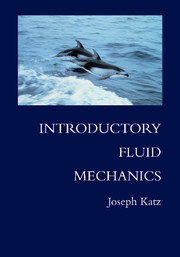Book contents
- Frontmatter
- Contents
- Preface
- A Word to the Instructor
- 1 Basic Concepts and Fluid Properties
- 2 The Fluid Dynamic Equation
- 3 Fluid Statics
- 4 Introduction to Fluid in Motion – One-Dimensional (Frictionless) Flow
- 5 Viscous Incompressible Flow: Exact Solutions
- 6 Dimensional Analysis and High-Reynolds-Number Flows
- 7 The (Laminar) Boundary Layer
- 8 High-Reynolds-Number Flow over Bodies (Incompressible)
- 9 Introduction to Computational Fluid Dynamics
- 10 Elements of Inviscid Compressible Flow
- 11 Fluid Machinery
- Appendix A Conversion Factors
- Appendix B Properties of Compressible Isentropic Flow
- Appendix C Properties of Normal Shock Flow
- Index
9 - Introduction to Computational Fluid Dynamics
Published online by Cambridge University Press: 05 June 2012
- Frontmatter
- Contents
- Preface
- A Word to the Instructor
- 1 Basic Concepts and Fluid Properties
- 2 The Fluid Dynamic Equation
- 3 Fluid Statics
- 4 Introduction to Fluid in Motion – One-Dimensional (Frictionless) Flow
- 5 Viscous Incompressible Flow: Exact Solutions
- 6 Dimensional Analysis and High-Reynolds-Number Flows
- 7 The (Laminar) Boundary Layer
- 8 High-Reynolds-Number Flow over Bodies (Incompressible)
- 9 Introduction to Computational Fluid Dynamics
- 10 Elements of Inviscid Compressible Flow
- 11 Fluid Machinery
- Appendix A Conversion Factors
- Appendix B Properties of Compressible Isentropic Flow
- Appendix C Properties of Normal Shock Flow
- Index
Summary
Introduction
The fluid dynamic equations developed in Chapter 2 are complex and cannot be solved analytically for an arbitrary case. Up to this point, the classical approach was presented in which major simplifications allowed some partial solutions. In recent years, however, numerical techniques and computational power have improved significantly. This facilitated the solution of the nonlinear fluid dynamic equations, which now can be added to the growing number of practical engineering tools.
There are two major advantages to the numerical approach when one is attempting to solve the fluid dynamic equations. The first is the possibility of solving these complex equations, which cannot be solved analytically. The process begins with a numerical approximation for the fluid dynamic equations. The fluid domain is then discretized into small cells or into a grid, where the equations are applied. By specifying the equations at each cell or point, we reduce the partial differential equations to a set of algebraic relations. Thus the second major advantage of the numerical approach is the ability to replace the nonlinear partial differential equations with a set of algebraic equations, which are usually solved by iterative methods. There are a large number of methods for approximating the equations, for grid generations, and for solution methodology. This chapter attempts to explain the generic principles of the numerical approach and the process leading to the numerical solutions.
- Type
- Chapter
- Information
- Introductory Fluid Mechanics , pp. 324 - 342Publisher: Cambridge University PressPrint publication year: 2010
- 1
- Cited by



